Edible Ornamental Plants
Español 
Many gardeners like to grow ornamental plants, indeed this aspect of gardening is usually given preference over food production. It is possible, however, to combine these two activities and this leaflet is intended to give a few examples on how it can be done. A number of traditional food plants such as Runner Beans, Ruby Chard and Globe Artichokes do not look at all out of place in a flower border - people can make their own minds up about the merits of including such plants in their ornamental areas. In this leaflet we will look, instead, at some of the more commonly grown ornamental plants that are also edible, for reasons of space, this will be restricted to bulbs and herbaceous perennials. For information on other edible and ornamental plants see our leaflet Edible Shrubs or contact us at the address below.
.jpg)
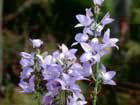 The family Campanulaceae contains many very pretty plants, a number of which are edible. All plants in the genus Campanula, which includes our native Harebells (or Bluebells, if you live in Scotland), have edible leaves, some also produce edible roots. Most of them are easily grown in a well-drained soil in sun or semi-shade. One of the nicest is C. versicolor from Europe, the leaves are very acceptable raw, and are rich in Vitamin C. Also worth trying for their leaves are two British natives C. latifolia and C. persicicfolia. The North American C. rapunculoides also produces a nice edible root but this plant can be quite invasive. The genus Adenophora is closely related to Campanulas. A. latifolia and A. ilifolia are particularly nice and both produce sweet roots that can be eaten raw or cooked. Easily grown in a warm, sunny position, they do unfortunately resent root disturbance so they are not easily divided. However, they are easy from seed and very young shoots can be potted up and will usually grow away well. Codonopsis is another relative of the Campanula, producing roots that can be eaten raw or cooked. To date we have not been very successful with this genus, plants are said to prefer a well-drained slightly acid soil in sun or semi-shade and they also resent root disturbance. C. ussuriensis has been our only real success to date, it is a lovely plant but has a very strange smell like over-cooked fried food. Others to try include C. lanceolata, C. ovata and C. pilosula.
The family Campanulaceae contains many very pretty plants, a number of which are edible. All plants in the genus Campanula, which includes our native Harebells (or Bluebells, if you live in Scotland), have edible leaves, some also produce edible roots. Most of them are easily grown in a well-drained soil in sun or semi-shade. One of the nicest is C. versicolor from Europe, the leaves are very acceptable raw, and are rich in Vitamin C. Also worth trying for their leaves are two British natives C. latifolia and C. persicicfolia. The North American C. rapunculoides also produces a nice edible root but this plant can be quite invasive. The genus Adenophora is closely related to Campanulas. A. latifolia and A. ilifolia are particularly nice and both produce sweet roots that can be eaten raw or cooked. Easily grown in a warm, sunny position, they do unfortunately resent root disturbance so they are not easily divided. However, they are easy from seed and very young shoots can be potted up and will usually grow away well. Codonopsis is another relative of the Campanula, producing roots that can be eaten raw or cooked. To date we have not been very successful with this genus, plants are said to prefer a well-drained slightly acid soil in sun or semi-shade and they also resent root disturbance. C. ussuriensis has been our only real success to date, it is a lovely plant but has a very strange smell like over-cooked fried food. Others to try include C. lanceolata, C. ovata and C. pilosula.
.jpg) Canna indica, often known as Indian Shot, is commonly grown in summer bedding displays, looking somewhat like a banana plant it adds an exotic air to the garden. Although from the tropics it is surprisingly tough and will often survive the winter outdoors especially if well mulched. Otherwise it can be stored in a frost-free place over winter but should not be allowed to dry out. The root is a bit fibrousy but very nice cooked, in the West Indies the root is dried and ground into flour to be used as an arrowroot. Easily grown from seed but usually purchased as plants since there are many named varieties.
Canna indica, often known as Indian Shot, is commonly grown in summer bedding displays, looking somewhat like a banana plant it adds an exotic air to the garden. Although from the tropics it is surprisingly tough and will often survive the winter outdoors especially if well mulched. Otherwise it can be stored in a frost-free place over winter but should not be allowed to dry out. The root is a bit fibrousy but very nice cooked, in the West Indies the root is dried and ground into flour to be used as an arrowroot. Easily grown from seed but usually purchased as plants since there are many named varieties.
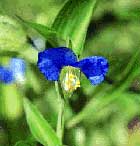 Commelina coelestis, the Blue Spider Wort, is a Mexican native that is about as hardy as a Dahlia, surviving mild winters outside, but usually stored over winter in a frost-free place in the same way as Dahlias. Very easy from seed, preferring a light well drained soil and a sunny position, by the end of the first summer each plant should have produced a clump of tuberous roots up to 4" long and about as thick as a baby's finger. These roots are edible, being starchy but with no pronounced flavour. The clump can be divided before replanting in spring but each division must have a growing bud.
Commelina coelestis, the Blue Spider Wort, is a Mexican native that is about as hardy as a Dahlia, surviving mild winters outside, but usually stored over winter in a frost-free place in the same way as Dahlias. Very easy from seed, preferring a light well drained soil and a sunny position, by the end of the first summer each plant should have produced a clump of tuberous roots up to 4" long and about as thick as a baby's finger. These roots are edible, being starchy but with no pronounced flavour. The clump can be divided before replanting in spring but each division must have a growing bud.
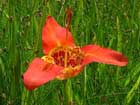 Tigridia pavonia, the Tiger Flower, is another Mexican plant and has the same cultivation requirements as Commelina though it seems to be hardier having survived the winter in the ground, both here and in Surrey. Very easy from seed, it flowers in its second year with beautiful blooms 4" or more across. Each flower only lasts one day but they are continually produced from June to October in a good year. The roasted bulb is similar to sweet potatoes.
Tigridia pavonia, the Tiger Flower, is another Mexican plant and has the same cultivation requirements as Commelina though it seems to be hardier having survived the winter in the ground, both here and in Surrey. Very easy from seed, it flowers in its second year with beautiful blooms 4" or more across. Each flower only lasts one day but they are continually produced from June to October in a good year. The roasted bulb is similar to sweet potatoes.
.jpg) Another Mexican bulb, which is particularly nice, is the Iron Cross Plant, Oxalis deppei. About as hardy as the Commelina and with the same requirements, this plant provides a succession of young leaves and flowers throughout the summer. Both leaves and flowers have a lovely acid-lemon flavour and are a delightful addition to the salad bowl though they shouldn't be eaten in large quantities because they contain oxalic acid. The plants have never set seed with us, but bulbs can be obtained quite cheaply and are best planted out in April. They die down in late autumn and if dug up each bulb will be found to have formed a tap root up to 3 or 4" long and about an inch in diameter with a clump of bulbs at the top. Keep the bulbs for next year and eat the tap root raw or cooked. It has the texture of a crisp juicy apple but, unfortunately, usually has very little flavour through occasionally it develops a lovely lemon flavour. We think this is either connected with climate or cultivation methods.
Another Mexican bulb, which is particularly nice, is the Iron Cross Plant, Oxalis deppei. About as hardy as the Commelina and with the same requirements, this plant provides a succession of young leaves and flowers throughout the summer. Both leaves and flowers have a lovely acid-lemon flavour and are a delightful addition to the salad bowl though they shouldn't be eaten in large quantities because they contain oxalic acid. The plants have never set seed with us, but bulbs can be obtained quite cheaply and are best planted out in April. They die down in late autumn and if dug up each bulb will be found to have formed a tap root up to 3 or 4" long and about an inch in diameter with a clump of bulbs at the top. Keep the bulbs for next year and eat the tap root raw or cooked. It has the texture of a crisp juicy apple but, unfortunately, usually has very little flavour through occasionally it develops a lovely lemon flavour. We think this is either connected with climate or cultivation methods.
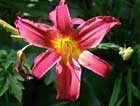
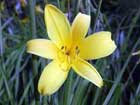 The Day Lilies, Hemerocallis species, are very common garden plants, and rightly so, being of very easy cultivation in most soils and situations though preferring at least some sun. Some species are cultivated for their edible flowers in the Orient, these can be eaten raw or more commonly dried and used as a flavouring in soups. Young shoots in spring can be eaten cooked whilst the root, which has a nutty flavour, can be eaten raw. Any member of this genus can be tried, we recommend H. fulva (especially the variety Kwanso or Green Kwanso) and H. lilio-asphodelus. For more details see our leaflet Hemerocallis Species - The Day Lilies
The Day Lilies, Hemerocallis species, are very common garden plants, and rightly so, being of very easy cultivation in most soils and situations though preferring at least some sun. Some species are cultivated for their edible flowers in the Orient, these can be eaten raw or more commonly dried and used as a flavouring in soups. Young shoots in spring can be eaten cooked whilst the root, which has a nutty flavour, can be eaten raw. Any member of this genus can be tried, we recommend H. fulva (especially the variety Kwanso or Green Kwanso) and H. lilio-asphodelus. For more details see our leaflet Hemerocallis Species - The Day Lilies
.jpg)
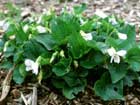 Violas are very common garden plants and are usually very easy to grow. All members of this genus have edible leaves and flower buds though it is probably best to avoid the yellow flowered species as these can be strongly laxative if eaten in quantity. Eaten raw or cooked, the leaves are often used to thicken soups. So far we've only grown V. odorata, V. mandschurica and V. tricolor but there are many more for you to try.
Violas are very common garden plants and are usually very easy to grow. All members of this genus have edible leaves and flower buds though it is probably best to avoid the yellow flowered species as these can be strongly laxative if eaten in quantity. Eaten raw or cooked, the leaves are often used to thicken soups. So far we've only grown V. odorata, V. mandschurica and V. tricolor but there are many more for you to try.
.jpg)
.jpg) There are a great many ornamental onions, Allium species. All members of this genus have edible leaves, flowers and often bulbs with flavours ranging from mild onion to strong garlic. Most are easily grown in a sunny position and a well drained soil. Among the more ornamental species are A. cernuum, A. neopolitanum, A. senescens and A. victorialis, all are quite strongly flavoured. A. urisnum, our native wild garlic, looks beautiful in spring, growing well in damp shade but it spreads vigorously and looks very untidy after flowering so is best in the wild garden.
There are a great many ornamental onions, Allium species. All members of this genus have edible leaves, flowers and often bulbs with flavours ranging from mild onion to strong garlic. Most are easily grown in a sunny position and a well drained soil. Among the more ornamental species are A. cernuum, A. neopolitanum, A. senescens and A. victorialis, all are quite strongly flavoured. A. urisnum, our native wild garlic, looks beautiful in spring, growing well in damp shade but it spreads vigorously and looks very untidy after flowering so is best in the wild garden.
 The Lily family contains many beautiful plants and a number of these are edible. Many Lily bulbs, for example, are edible cooked and some species are cultivated as vegetables in China and Japan. Perhaps the easiest of these to grow is Lilium lancifolium, the Tiger Lily. This species resists the effects of virus diseases which are a great bane of Lily growing but since it harbours these diseases it should not be grown near other Lilies. Many species are difficult to cultivate but some of the easier ones to try include L. bulbiferum, L. candidum, L. pardalinum and L. speciosum.
The Lily family contains many beautiful plants and a number of these are edible. Many Lily bulbs, for example, are edible cooked and some species are cultivated as vegetables in China and Japan. Perhaps the easiest of these to grow is Lilium lancifolium, the Tiger Lily. This species resists the effects of virus diseases which are a great bane of Lily growing but since it harbours these diseases it should not be grown near other Lilies. Many species are difficult to cultivate but some of the easier ones to try include L. bulbiferum, L. candidum, L. pardalinum and L. speciosum.
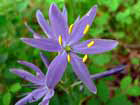 Camassia Quamash is a North American bulb related to Lilies, the bulb has a delicious chestnut-like flavour when baked and it is easily grown in most soils and situations. Easily raised from seed, it usually flowers in its third year and thereafter increases quite freely by division. C. leitchlinii can also be used.
Camassia Quamash is a North American bulb related to Lilies, the bulb has a delicious chestnut-like flavour when baked and it is easily grown in most soils and situations. Easily raised from seed, it usually flowers in its third year and thereafter increases quite freely by division. C. leitchlinii can also be used.
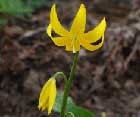 Dog's Tooth Violets, Erythronium species, are another Lily relative for light soils and some shade. E. dens-canis is a European plant, it is very slow from seed but bulbs divide freely in good conditions and will naturalise in thin grass. The bulb is edible cooked or dried, and ground into a flour, the leaves can be cooked. Other species to try include E. americanum and E. grandiflorum. A word of warning though, the bulbs can cause dermatitis in some sensitive people.
Dog's Tooth Violets, Erythronium species, are another Lily relative for light soils and some shade. E. dens-canis is a European plant, it is very slow from seed but bulbs divide freely in good conditions and will naturalise in thin grass. The bulb is edible cooked or dried, and ground into a flour, the leaves can be cooked. Other species to try include E. americanum and E. grandiflorum. A word of warning though, the bulbs can cause dermatitis in some sensitive people.
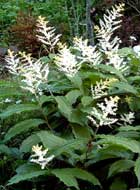 Smilacena racemosa, or False Spikenard, is a plant for most soils and some shade. The seed can be very slow to germinate but otherwise the plant presents no problems in cultivation. The fruit can be eaten raw or cooked and has a bitter-sweet flavour, it can be laxative in large quantities. Young shoots in spring are an asparagus substitute, the rootstock is also edible but should be soaked first to remove a bitter flavour. S. stellata has similar uses and perhaps a nicer fruit.
Smilacena racemosa, or False Spikenard, is a plant for most soils and some shade. The seed can be very slow to germinate but otherwise the plant presents no problems in cultivation. The fruit can be eaten raw or cooked and has a bitter-sweet flavour, it can be laxative in large quantities. Young shoots in spring are an asparagus substitute, the rootstock is also edible but should be soaked first to remove a bitter flavour. S. stellata has similar uses and perhaps a nicer fruit.
 The Milkweeds, Asclepias species, are also very ornamental plants with many uses, see our leaflet The Milkweeds.
The Milkweeds, Asclepias species, are also very ornamental plants with many uses, see our leaflet The Milkweeds.
Database
The database has more details on these plants: Adenophora latifolia, Allium senescens, Allium victorialis, Asclepias latifolia, Campanula latifolia, Campanula rapunculoides, Canna indica, Codonopsis lanceolata, Codonopsis ovata, Codonopsis pilosula, Codonopsis ussuriensis, Commelina coelestis, Erythronium americanum, Erythronium dens-canis, Lilium bulbiferum, Lilium candidum, Lilium lancifolium, Lilium pardalinum, Lilium speciosum, Oxalis deppei, Smilacina racemosa, Smilacina stellata, Tigridia pavonia, Viola mandschurica, Viola tricolor.
(1).jpg)